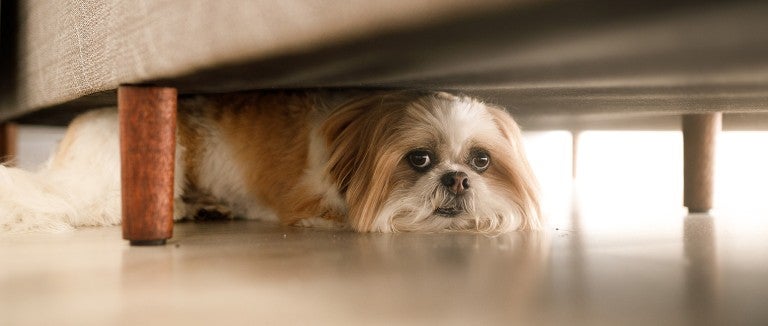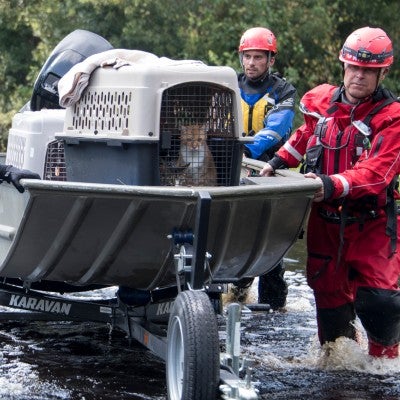The anticipation of a storm can give many pets and their owners anxiety. We don't always know why some dogs are afraid of thunder, and these types of fears may develop even if your dog has had no traumatic experiences associated with the sound. The good news is that many fear-related problems can be successfully resolved. If left untreated, however, your dog's fearful behavior can potentially become worse.
Outlet for anxiety
When a dog becomes frightened, they try to reduce their fear. They may try to escape to a place where the sounds of thunder or firecrackers are less intense. They may feel less afraid by leaving the yard or going into a certain room or area of the house.
The most common behavior challenges associated with fear of loud noises are extreme fear behaviors, such as salivating and trembling, and destruction of crates or other objects as a means of escaping or hiding. For some dogs, just the activity or physical exertion associated with one of these behaviors may be an outlet for their anxiety. Unfortunately, escape and/or destructive behavior can be a problem for you and could also result in physical injury to your dog.
Fear by association
Your dog may also begin to associate a particular startling noise with other things in their environment and they may grow afraid of these other things because they are associated with the frightening loud noise. For example, dogs who are afraid of thunder may later become afraid of the wind, dark clouds and flashes of light that often precede the sound of thunder.
Dogs who do not like the sound of firecrackers may become afraid to go in the backyard, if that's where they usually hear the noise.

What you can do for a dog scared of thunder
1. Create a safe place
Create a safe place for your dog to go when they hear noises that frighten them. Notice where they go (or try to go) when afraid. If possible, give them access to that place. If they're trying to get inside the house, consider installing a dog door. If they're trying to get under your bed, give them access to your bedroom.
You can also create a "hidey-hole," such as a covered crate, that is dark, small and shielded from the frightening sound as much as possible. Encourage them to go there when you're home and the thunder or other noise occurs. Consider using a fan or radio near the spot to help muffle the sound. Feed them in that location and help your dog associate that spot with other good things that happen there. They must be able to come and go from this location freely. Confining them in a crate or other small space when they don't want to be there will only cause more anxiety.
The "safe place" approach may work with some dogs, but not all. Some dogs are motivated to move and be active when frightened and "hiding out" won't help them feel less fearful.
2. Distract your dog
This method works best when your dog is just beginning to get anxious. Encourage them to engage in any activity that captures their attention and distracts them from the thing they’re afraid of.
Start when they first alert you to the noise. Immediately try to interest them in doing something they really enjoy. Play fetch (in an escape-proof area) or practice some tricks. Reward with praise and treats for paying attention to the game. If your dog is food-motivated, put some treats in a puzzle toy to keep your dog busy.
As the storm or other noise builds, you may not be able to keep their attention on the activity, but it might delay the start of the fearful behavior for longer and longer each time you do it. If you can't keep their attention and they begin acting fearfully, stop the process.
3. Behavior modification
Behavior modification techniques are often successful in reducing fears and phobias. The appropriate techniques are called "counter-conditioning" and "desensitization."
These techniques must be implemented very gradually and they condition or teach your dog to respond in non-fearful ways to sounds and other stimuli that have previously frightened them.
Begin by exposing your dog to a very low level of noise that doesn't frighten them and pair the noise with something pleasant, like a treat or a fun game. Gradually increase the volume as you continue to offer something enjoyable. Through this process, they'll come to associate "good things" with the previously feared sound.
For some fears, it can be difficult to recreate the fear stimulus. For example, thunder is accompanied by lightning, rain and changes in barometric pressure; your dog's fearful response may be to the combination of these things and not just the thunder. You may need professional assistance to create and implement this kind of behavior modification program.
4. Consult your veterinarian
Medication may be available which can help reduce your dog's anxiety levels for short time periods. Your veterinarian is the only person who is qualified and licensed to prescribe medication for your dog.
Don't attempt to give your dog any over-the-counter or prescription medication without consulting your veterinarian. Animals don't respond to drugs the same way people do and a medication that may be safe for humans could be fatal to your dog. Drug therapy alone won't reduce fears and phobias permanently, but in extreme cases, behavior modification and medication used together might be the best approach.
What not to do
- Do not put your dog in a crate to prevent them from being destructive during a thunderstorm. They'll still be fearful while in the crate and likely to injure themselves, perhaps even severely, while attempting to get out.
- Do not punish your dog for being afraid. Punishment will only increase the fear.
- Do not try to force your dog to experience or be close to the sound that frightens them. For example, making them stay close to a group of people who are lighting firecrackers will only make them more afraid. Providing your dog with the choice to leave a situation is one of the best ways to help them cope with their fear.
When all else fails
If your dog has severe fears and distracting games, hiding spaces and counterconditioning don't improve their fear, consult with an animal behavior specialist and your veterinarian.

